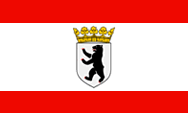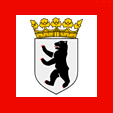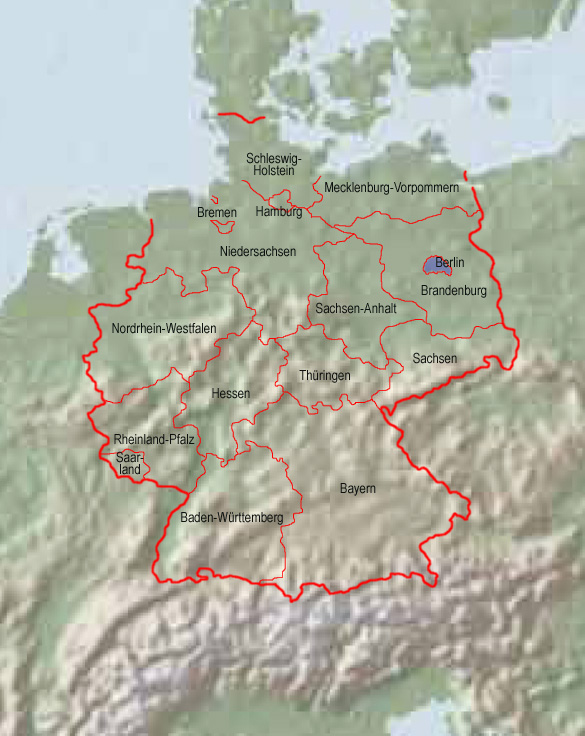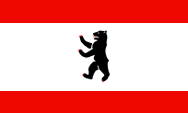



since 1934,
Official flag of Great Berlin, flag of East Berlin since 1956,
Source, by:
Flags of the World,
Corel Draw 4,
Jürgen Kaltschmitt




1954–2007,
General official flag,
Source, by:
Wikipedia (D)






1954–2007,
Flag of the senate,
Source, by:
Wikipedia (D)




Initialy showed the flag of Berlin three horizontal stripes in black, red and white. The colours have their roots in the colours of Brandenburg (red and white) and in the colours of the coat of arms of Berlin (black and white). In the year 1911 was introduced the today's flag. It shows three horizontal stripes in the colours red, white and red in ratio 1:3:1 with a straighten red armed black bear in the middle of the white stripe. As Berlin became a Prussian province they took over that flag for official purpose and maintained it to 1934. After 1945 this flag was used again and is today the flag of the country of Berlin. It is everybody allowed to use it, provided that this is not made in a kind or under conditions which are harmful for the esteem or the dignity of that symbol.
On 13th of May in 1954 West Berlin introduced a new coat of arms (created by Ottfried Neubecker). It shows the bear on a silvery shield with a golden leafage crown. This coat of arms was used accordingly since the in this point in time introduced general official flag. The general official flag could be used instead of the flag of the country by those departments and offices of the Country of Berlin which work prevalently in sovereign assignments. The senate had an own official flag. That official flags and also the coat of arms were valid since the re-unification for whole Berlin. In 2007 all official flags became abolished.
East Berlin introduced in 1956 likewise the red-white-red flag of Berlin, but it showed in it the coat of arms of 1934. It was obviously not used for a long time. On the occasion of the festivity of "750 years of Berlin" was used s special form of this flag. It showed on the outer borders additionally slender white stripes.
Source: Die Welt der Flaggen,
Wikipedia (D),
Volker Preuß


1875–1934(?),
Coat of arms of Berlin
Source, by:
Wikipedia (D)

1934–1954,
Coat of arms of Berlin
Source, by:
Wikipedia (D)

since 1954,
Coat of arms of Berlin
Source, by:
Wikipedia (D)

The coat of arms of Berlin is a so named speaking coat of arms. It shows a straighten red armed "small bear" in black on silvery ground. Above the coat of arms a golden leafage crown with a gate in it. In this form (created by Ottfried Neubecker) it was introduced on 13th of May in 1954 in West Berlin and in 1990 it was tooken over for the whole city. The bear as a symbol of the city dates back to the year 1307, when Berlin and Cölln joined together for the first time. Berlin had indroduced in 1934 a coat of arms which showed the bear on a silvery red bordered shield with a red mural crown. This coat of arms maintained from East Berlin until the unification of both parts of Berlin in 1990.
Source: Die Welt der Flaggen,
Wikipedia (D),
Volker Preuß

FRG and its countries, clickable map:

Source: Volker Preuß

Area: 344 square miles
Inhabitants: 3.480.000 (2011)
Density of Population: 10.116 inh./sq.mi.
Religions: 19% Protestant, 9% Roman Catholic, 3% other Christian, 6% Muslim
Source: Wikipedia (D)

ca. 1160 · Margrave Albrecht I. (the Bear), colonizes Berlin targeted – before probably a Slavic settlement
1307 · Berlin becomes united with the City of Cölln
1442 · Berlin and Cölln become separated
1470 · capital of the Electorate of Brandenburg
1701 · capital of Prussia
1710 · Berlin, Cölln, Friedrichswerder, Dorotheenstadt and Friedrichstadt become united to the capital and residence city of Berlin
1871 · capital of the German Empire
1st of October 1920 · creation of the municipal community of Great Berlin as Prussian province
1934 · the territorial structure of the states of the German Empire becomes replaced by the districts of the NSDAP, the countries become meaningless
1945 · occupied and separated by the allies
1948 · separation into East Berlin and West Berlin
1949 · East Berlin became capital of the GDR
1961 · construction of the "Berlin Wall" around West Berlin
1989 · fall of the "Berlin Wall"
1990 · unification of Berlin
1990 · capital of the FRG
15th of March 1990 · conclusion of ratification of the 2+4 Treatys and in this way ending of some of the allied reservations referring to the status of Berlin in the "Grundgesetz" and the constitution of Berlin
20th of June 1991 · seat of government of the FRG
1994 · withdrawal of the allies
Quelle: Wikipedia (D)

The name "Berlin" is known since the 12th century, and in creating the emblem of the city in 1307, they made an allusion with the Bear in the crest to the name "Berlin" as a "Bärlein" (little bear). However, the name may be older and is of Slavic origin, and the first syllable in the word "Berlin" is a reference to the word "swamp".
Source: Handbuch der geographischen Namen,
Atlas der wahren Namen
![]()





























![]()